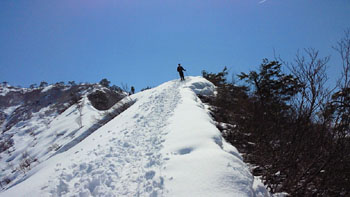From my recent diary
2012
Friday, December 14
I have been waiting for the clear sky, and finally the time has come. Though
this was the second hunting session this month, the previous one was only 20
minutes because of the cloudiness during the session.
I was lucky enough to comet search at the night of the peak of Geminids. While
I was setting up my comet-seeker, I saw several meteors, and I did additional
one dozen of them during the session.
The air temperature was -5 degrees Celsius but it was calm and no frost
condensed on my polar wear and the telescope. The transparency was not good at
the low altitude, but was excellent near the zenith. I started the session from
some 10 degrees south of Arcturus. Before the beginning of the session I felt
the temptation to observe C/2012 F6 Lemon and C/2012 K5 LENEAR but I restrained
to do, as I overslept slightly and did not have enough time to search.
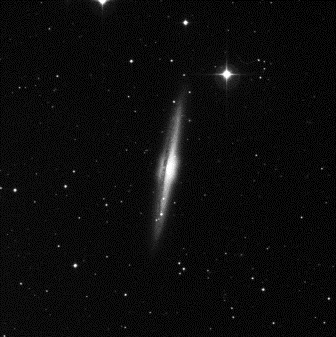
NGC5746. The image
size is 15f.
The
Digitized Sky
Survey copyright©1994
I knew that there are no bright nebulae in the area I swept, but unexpectedly four
galaxies came into the FOV: NGC5566, 5638, 5746 and 5846. NGC5746 was
impressive since it is very elongated with 9th magnitude star on the
north- northeast.
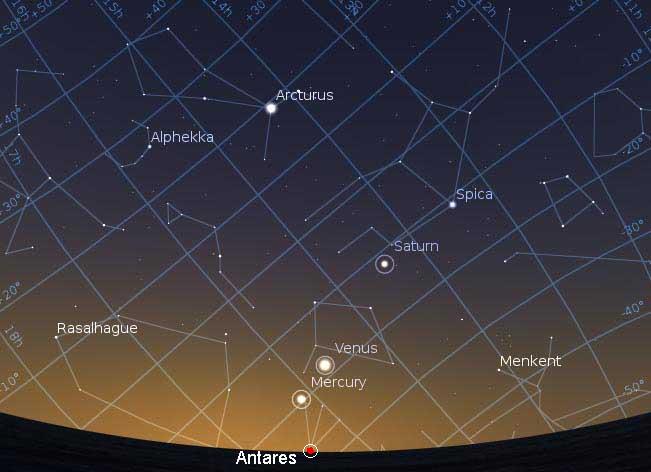
The eastern sky at the time of twilight on Dec. 13 UT.
©Stellarium
In many respects this session was gorgeous. A few meteors passed across the FOV
in addition to naked observation, and M5 that looked like a splendid flower unexpectedly
came into the FOV. When I finished the session, Spica, Saturn, Venus and
Mercury welcomed me; however, disassembling the telescope another bright star
appeared just above the horizon. It was Antares. Tsutomu Seki said cold reaches
the peak the time when Scopus rises, and I realized that the midwinter is just
around the corner.
Saturday, November 24
I have been in Cairns, Australia, last week and observed the total solar
eclipse for the first time! It was great and looked ethereal. I also have
observed Large and Small Magellanic Clouds for the first time.
When I visited Australia last time, the weather was abnormal and I just recognized
the existence of LMC under the moonlight.
When I went to Jiaxing near Shanghai China to observe the total eclipse it
rained heavily.
This time everything was fine!
Click here for details of the eclipse
Saturday, October 20 to Monday, October 22
There were many fine days in October and this was the sixth comet hunting
session this month. I was happy to comet hunt three consecutive predawns. Among
three seeeions, Saturday was the most impressive.
Saturday
The moment when I was about to insert the primary mirror that weights 18 kg
onto the mirror cell, the strong flash light was emitted from behind. Just
after I set the mirror I looked up the sky. A liner shaped meteor trail with 1st
magnitude some 10 degrees in length was shining at the foot of Orion. I could
not see the meteor itself but I enjoyed watching the trail. It deformed into
round shape and was visible over 3 minutes. It was Orionids. The page below
said the meteor was -6th magnitude.
http://www.astroarts.jp/photo-gallery/gallery.pl/special/173
Prior to the session I observed 168P
Hergenrother. The comet was more defused than I observed on October 9, but the
impression of the tail with 3f in length was the same.
At 3:20am I started with hunting session from Regulus. The first nebula that
came into the FOV was NGC3041, a 12th galaxy. Then, I identified 21
galaxies including major bright ones like NGC2903, M95, M96, M105, M65 and M66.
Probably, the darkest one was NGC3248 with a magnitude of 12.5.
Sunday
I did not expect clear sky when I went to bed last night and I did not set the
alarm clock. I woke up at 3:20am, and noticed the sky was clear. I hurried up
and went to the nearest observing site. I began to the session at 3:55 but the
twilight would begin within 30 minutes. I could not sweep the east due to the
light pollution at the site, and I was forced to sweep the southeast or the
south. I decided to start with M46. A planetary nebula in this open cluster, NGC2438,
was easily visible. Fine-spun stars in the winter Milky Way were passing in the
FOV.
A nebula like object hopped into the FOV and I realized it as a galaxy at a
glance. It turned out to be NGC2784 in Hydra. I completed the session in one
hour without identifying any other comet-like objects.
Monday
It was heavy fog when I left home for the site, but the sky was clear at the
site. However, it was humid with poor transparency. I trained my comet-seeker
at Cor Hydræ and began to sweep
the sky at 3:15. The comet-like objects that came into the FOV were NGC2716, 2713,
3115, 2775, 3166, 3169, and 3521. I noticed halo around a bright star in the
FOV that was formed by slight dew condensation on the secondary mirror. At the
time of the daybreak Venus emitted the soft light through haze.
Sunday
September 16
Last month I
conducted comet hunting sessions 8 times that I think the record
high in August.
The
transparency was excellent this predawn since it rained at midnight.
The
sky was gorgeous with Jupiter and Venus in addition to many bright
stars in the
winter constellations. The fragile beauty of the Milky Way that flows
among the
autumn and winter constellations and the zodiacal light were luxurious.
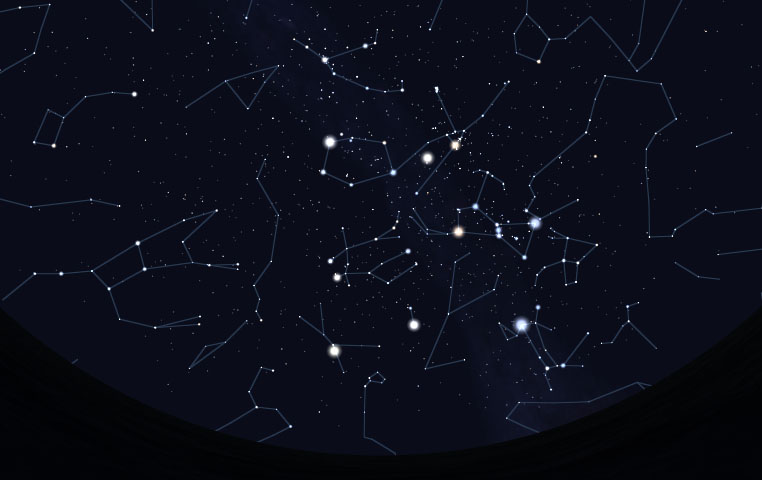
The eastern sky at the time of twilight on Sep. 16.
©Stellarium
This was the
successive comet hunting session from yesterday. When I set up my
comet seeker and just tried to introduce the second star to initialize
the NGC
SkyVector, Castor, I witnessed a fire ball with a magnitude of -3. I
saw a
meteor trail soon by naked eye, and I aimed my 46 cm telescope at the
trail. I
observed the trail that was divided into two. It was changing the shape
slowly
with the length of over 10 degrees. What a wonderful opening of the
session!
Yesterday I
completed the searching session when Venus passed through the FOV,
and today I began with Venus. The first comet like object that came
across the
FOV was NGC2371, a planetary nebula in Gemini. The visual magnitude was
11th though
the photometric one is 13. The next object I identified was NGC2672, an
11th magnitude
galaxy in Cancer. The altitude was only 16 degrees and Venus was
shining only 2
degrees from the galaxy. It was challenging to catch this galaxy even
under
excellent transparency, but I did well if I do say so. The third one
was NGC2903,
a bright galaxy in Leo. The altitude was very low, only 10 degrees, but
I
noticed a spiral arm at a glance. The last object was NGC2683, an
elongated
galaxy in Lynx. The edge-on shape of the galaxy was beautiful.
The seasons
rounded before I know it; the sickle of Leo appeared again
magnificently,
and Hydra reared its head in the eastern sky.
Sunday, August 19
This month I comet hunted once at dusk, and today was the second
hunting
session at predawn. This was the first complete clear sky in August;
during the
other sessions I was always bothered by cloud. I trained my
comet-seeker on
Jupiter and started there.
Messier 1 must be the only comet like object in my searching area
today.
Interesting thing was that if I could identify 185P Petriew that was
surely
within the searching area. Messier 1 shining brightly went through FOV
as
scheduled, and I went on the session. A comet like object passed
through FOV again
and I was surprised. I moved the telescope and introduced it into the
center of
the field. It turned out to be NGC2158, a lovely open cluster
accompanying M35.
This cluster well resolved into stars with 46 cm comet-seeker, but it
looked
like a comet at the edge of FOV.
After a short time Venus passed through FOV, but 185P would had come
into FOV
before it. I overlooked the comet. It was challenging to spot this
comet during
the session, since it was 15 degrees above horizon at that time
(2:40a.m.) with
11th magnitude and defused image. Venus was shining only 3.2
degrees
from the comet and zodiacal light was also illuminated the area. I
tried to
introduce the comet using Starmap Pro., an app of iPod, but I could not
identify 185P at a glance. I peered into FOV for a while and I noticed
the
comet with some 1f in diameter. The comet was too faint to spot during
the
session. I observed 185P last time in 2002. The last return was
February 2007,
but I could not see the comet due to bad weather.
Changing the mood I continued the session and another comet like image
came
across FOV. In a moment I remembered the object; NGC1931, a
mixed emission-reflection nebula in Auriga. After that I
enjoyed beautiful
winter Milky Way and open clusters in FOV, and then I aimed my
comet-seeker at
185P again at 3:40a.m. The altitude of the comet was 27 degrees and the
image was
so clear that I could not miss. Apparent diameter was over 3f. Assuming
that
this comet was a new one, you could not discover it at 2:40a.m. but you
could
at 3:40a.m. Probably, around 3a.m. (altitude of some 20 degrees) must
be the
divide. What we have learned is that a slight difference in the
condition leads
you to the discovery.
At 3:51a.m. the sky was getting brighter and my comet-seeker reached
the
horizon. When I decided that this was the end of todayfs session, a
bright star
came into the field. I found it Mercury at a glance. I could also see
it by
naked eye. Beautiful daybreak with high transparency.
Sunday,
July 29
It has been nasty
weather throughout this month. I got up at least four times at predawn,
but it has
been always cloudy or hazy at an altitude of lower than 40 degrees.
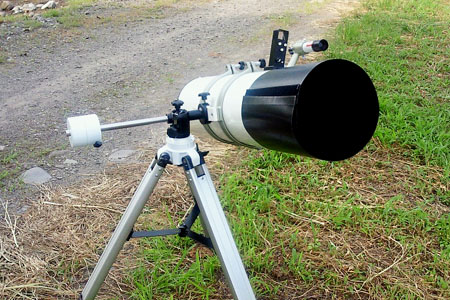
Giro-WR with 20 cm ref. The details are here.
My
main comet seeker is 46 cm Dob, and I seldom use other telescope
nowadays.
The major reason is that Carton TA Atl-Az mount for 20 cm ref. and 12.5
cm ED
is too heavy to intend to set up. This month I have renewed the Alt-Az
mount
and I believe this new system is very handy. The mount is Giro-WR, a
German
made mount. It features free-stop with precise tracking. I installed a
graduated azimuthal ring and a clinometer which works as digital
setting circles
using with a planetarium app of iPod.
Saturday,
June 30
It was lucky enough to conduct comet hunting sessions five times this
week. It
was cloudy on Monday, hazy on Friday but I swept the sky on the other
days.
I tend to have lack of sleep in this time of the year. The beginning of
the
twilight is half past 2, and I need to get up at 1a.m. to take
sufficient time
for comet searching.
On Wednesday the transparency was excellent and I identified three
nebulae:
NGC7293 (Helix nebula), 7392, and 7606. NGC7293 has a large apparent
diameter and
I was always astonished when the nebula came into the FOV. NGC7392 is a
12th
magnitude galaxy that is the limit magnitude to detect under the
condition of
the night.
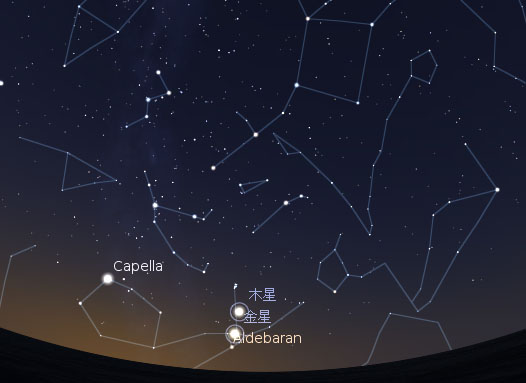
Jupiter and Venus in the twilight.
©Stellarium
What I thought during the session.
A star shines because of the existence of darkness.
Lo, pure true world. That is the place where we are from and where we
are going
to go.
Lo, regal dignity of Jupiter and candor of Venus.
When the daybreak robbed Jupiter of the dignity and hides Venus with
the veil
of daylight, the real world with full of deceptions revives.
I remembered Minoru Hondafs saying.
You see farther during the dark night
than in the bright daytime
As far as the star world
Saturday, June 2
The alarm clock rang at 1 a.m. and I tried to get up but had a hard
time to do.
I could manage to get out of my bed and looked up the sky from the
eastern
window. There appeared no stars on the sky. I intended to get back to
my bed
but I felt something was wrong. At the next moment I saw the sky from
the
southern window and found stars were shinning. I could not notice stars
in the eastern
sky due to the moonlight.
While I was setting up my comet-seeker, the moon went down and stars
began to
shine more brilliant with time. I was happy to see the Milky Way
appeared.
I started the hunting session from M22 that was just at the meridian at
1:45
a.m. As the moon was nearly full, I guessed many comet hunters in the
world had
searched around the ecliptic, i.e. the constellation of Aquarius, in
several
days. This was the reason why I wanted to seek the south or the east.
The visibility
in the eastern sky was poor from the todayfs observing site, and I
decided to
search the southern sky.
The Deep Sky Objects I identified were M70, M54, NGC6723, 6726, M55,
and M75.
Among these, only NGC6726 was a reflection nebula and the others were
globular
clusters. The culmination altitude of NGC6723 and 6726 is only 16 and
I
wondered if I have ever seen these objects during the session. NGC6726
looked
bluish white.

Upper
right: NGC6723, left center:
NGC6726 and lower left:
NGC6727
Copyright©WIKISKY.ORG
The moon set at 2:10 a.m., and the
beginning of the twilight was
at 2:30. The moonless time I enjoyed was only less than half an hour
when the
Milky Way was impressive.
Monday, May 21
The sky was very clear! Wonderful annular solar eclipse!
I took off today, and my wife and I went to Matsumoto Air Port
(3609f04hN, 13755f37hE),
which is located on the northern limit line of the eclipse and the bast
place
to observe Bailyfs beads. I set up Borg 125ED and 8x50 binocular for
visual
observation and Borg 60ED for photography.
We enjoyed the eclipse perfectly. The Bailyfs beads was impressive! Air
temperature fell down significantly at the time of the annular eclipse
and we put
our jackets on.
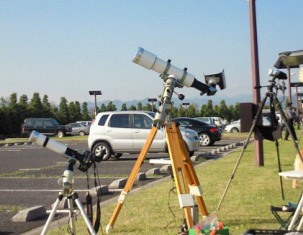
From left to right: Borg 60ED, Borg 125ED and 8x50 binocular.
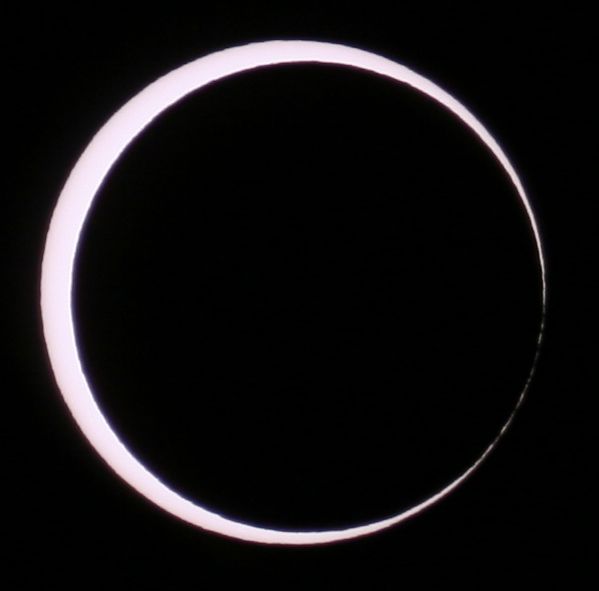
07:34:04 JST, May 21, 2012
Borg 60ED, Canon 20Da, Baader Planetarium AstroSolar Safety film
Accidentally, I met an acquaintance of National Astronomical
Observatory of
Japan and the editor-in-chief of a astronomical magazine at the site. I
had a
good time with them.
Sunday, May 20
Every predawn I got up it was cloudy. I conducted only one comet
hunting
session this month so far. However, I am sure we can enjoy annular
eclipse tomorrow
morning. The forecast is positive though we cannot expect perfect clear
sky.
I received the plaque for the Edgar Wilson Award, and updated the page
of gAbout
meh. But there is no announcement about the award.
Saturday, May 12
It has been cold and cloudy this month, and I comet hunted only once.
In the
past there were cold periods that were related to solar inactivity,
such as Maunder
Minimum, though the mechanism is not known. I guess this trend will
continue
for several decades from now.
I, as a professional scientist, cannot approve the hypothesis of global
warming,
although I do not strongly deny it. The hypothesis claims that increase
in
carbon dioxide originated by anthropogenic activities gives rise to
temperature
on the planet, but there is no direct observational evidence to support
the
hypothesis.
Last week, I climbed Mt. Sakato, 634 m above sea level (3703f33hN,
13853f55hE).
Recently, I went to the mountain almost every week.
http://www.kimurass.co.jp/sakatoyama.htm
Last
month the ridge was covered with snow, but this time a
community of pretty flower, Erythronium japonicum Decne,
were at their best, and I felt I had been a diferent place.
Mt.
Sakato. April 2012 (left) and May 2012 (right).
Tsutomu Seki in his eighty keeps swimming for fitness, and he continues
comet
hunting and observations. I go skiing and trekking for my health. I am
considering climbing Mt. Sakato tomorrow again.
Saturday,
April 28
This is the fifth comet hunting session this month. This predawn the
sky was
clear without a speck of cloud, contrary to the other sessions during
this
month in which I was disturbed by scattered clouds.
I searched near the ecliptic in a conventional way; mainly Aquila,
Capricornus,
and Aquarius. The deep sky objects that came into the FOV were only M72
and M2.
I could have felt satisfactory, if I had encountered more of them.
Stars that I
saw with being settled after a long interval were beautiful,
especially, the
Milky Way in Aquila looked like golden sands scattered on the heaven.
What I thought during the session:
Stars shining in the distant part of the universe are not capable of
sin.
However, those who obtain this sacred brilliance to hold supremacy or
to hunt
for rights and interests are defiled. Originally, the brilliance is
holy and must
not be used by human beings. Those who are unclean are still trying to
hide the
sin even though they have harmed many people. How stupid!
We need to shut down all atomic powers on this planet.
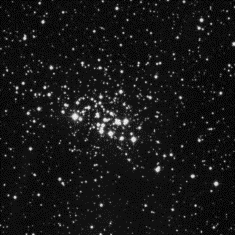
NGC7510. The image
size is 10f.
The
Digitized Sky
Survey copyright©1994
The session on April 17, I identified the NGC number of a certain
asterism that
I observed many times in the past. It was NGC7510, open cluster in
Cepheus. The
Night Sky
Observer's Guide reads gA real surprise –at all powers!h Actually, the
asterism
is impressive.
I observed another impressive object on April 19: NGC6717, a globular
cluster
in Sagittarius. It was some 1f in diameter with my 46 cm comet-seeker,
and
located only 2f south of Nu 2, a 5 magnitude star. The magnitude of the
cluster
is 9th, but as it is near the bright star with the small apparent size
I have probably
overlooked this object until now. With higher magnification, 157x, the
stars in
the cluster was sparse like an open cluster, but astronomically this
object is
classified as an globular cluster.
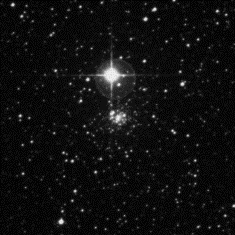
NGC6717. The
image size is 10f.
The
Digitized Sky
Survey copyright©1994
The fine weather seems to continue for several days from now.
Saturday, April 7
In March I got up at predawn six times, but I could comet hunt only
twice. The
nasty weather has lasted through this month. At present I comet
searched only
once in April, when I did only 40 minutes because of high percentage of
the
cloud cover during the session. Today it is snowing steadily like in
mid winter
and newly fallen snow depth has reached 20 cm since yesterday.
On the Edgar Wilson Award
Ikeya and I must be candidates of
the winners of the Edgar Wilson Award for the
discovery of P/2010 V1 Ikeya-Murakami. However, I heard nothing from
the Smithsonian
Institute after July in 2011 when the announcement would have been
made. I
though the award had been canceled for some reasons.
In this February, suddenly, I
received an email from Christine Pulliam, a
public affairs specialist at the Harvard-Smithsonian Center for
Astrophysics.
She said I won the award and was requested to let her know information
on the
wire transfer. I have received the award money at the end of March, but
have
not yet accepted the plaque.
There seems to be no formal
announcement on the award winners via IAUC, and the
winners are not only Ikeya and I judging from the amount of money I
received. I
think we are the only winners for the year of 2011 and the other
persons and
organizations are not qualified. What happens?
I heard from Pulliam again this
month. She said she could not contact Ikeya and
wanted to know his email address. I know Ikeya is not a user of email
but I
thought I should help her.
I phoned Ikeya and told him the
situation. He said he had received a letter
from Smithsonian Institute on the award that read he let them know
information
on the wire transfer. But he could not follow how to fill the form
exactly and would
ask his son to read the documents when his son visited his home.
As he said it was hard for me to
understand how to fill the forms. I faxed the
forms that I have submitted to him and told him to fill the forms in
the same
way I did. I emailed what I did to Pulliam, and she replied with the
forms in
which Ikeya just adds the wire transfer information with his signature.
Again,
I sent a fax to Ikeya and had a talk with him by phone to tell him how
to sand
an international fax. Finally, he would be able to get the award money
and the
plaque.
At any rate, I wonder what the lengthy delay of the winnersf
announcement and
changes in the rules imply. Ikeya told me he thought the award had
canceled as
I imagined. Upon the last prize-winning I used email to contact with
Smithsonian Institute but Dr. Marsden helped Ikeya communicate with SI.
The earth crust and the climate are getting unstable worldwide, which
gets political
and economic regime along with governing structure of various kinds of
organizations changeable. Nevertheless, shining of a star is permanent.
Monday, March 12
Today is the 10th anniversary of the discovery of C/2002
E2 Snyder-Murakami.
Just like the year of 2002, to date I conducted comet hunting sessions
only 3
times from February. This is not because of my laziness but nasty
weather.
The weather service says it will be bad weather for a week from today.
This
month I got up three times before 3a.m. but I could go comet hunting
under a
starry sky only once. Another predawn, I left home for the observing
site but I
was clouded out before I got to the site. I was forced to get back
home. The
other time, I confirmed cloudy sky from a window of my room. The
forecast
predicted clear sky for these three predawns, but the results were like
this.
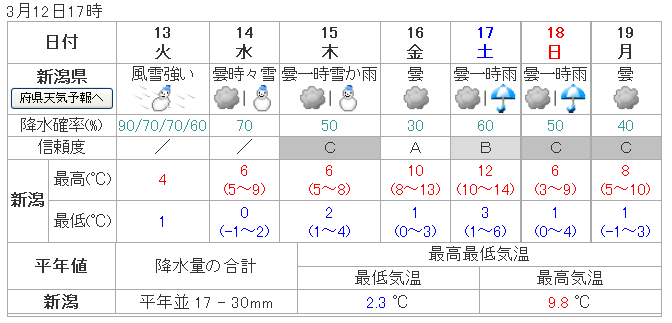
Weekly forecast from March 12, 2012
Japan Meteorology Agency
A person said it was impossible to discover a new comet in Niigata
Prefecture where
I live because of low chance of clear sky. It is true that one has such
a
feeling since there are so many days with bad weather. I have been
irritated
and felt frustrated by nasty weather, but I need not to strain to comet
hunt.
If only I am patient, I have great enjoyment and have a pure mind with
clear
sky, which shines stars more brilliant in my mindfs eye. This may be
one of the
reasons I can keep searching.
I may be lucky. In 2010 I discovered my second named comet, P/2010 V1
Ikeya-Murakami, and in 2004 I spotted P255 (C/2006 T1) Levy, though
this was
not an official discovery. Moreover, in 2004 I experienced unconfirmed
comet discovery
in Scutum. I encountered many comets during a little over 980 hours of
comet
hunting.
I have a feeling that the 980 hours is equivalent to 2000–3000 hours of
searching
for comet hunters who live on the Pacific side where the chance of
clear sky is
much higher. I keep waiting for clear sky patiently, even if I have
experienced
cloudy sky so many times when I got up in the wee hours. I cannot
remember how
many times it got cloudy at the observing site just when I set up my
telescope.
Even worse, sometimes it started raining or snowing suddenly.
I will have a starry sky in due time. I will wait patiently for the day
to come
to have a premium time with brilliant stars and to luck out in a new
comet
again.
Saturday, February 25
During one week I comet hunted two
consecutive predawns, and enjoyed a comet observation.
Sunday, February 19
I observed C/2012 C2 Bruenjes discovered on February 11 UT by the US
amateur using
a 36 cm Schmidt-Cassegrain with CCD. This comet could have discovered
visually
with a large aperture telescope as the reported visual magnitude was
10th.
I tried to observe this comet at dusk under moderately light polluted
condition. The major light sources were the lamps of ski fields for
night
skiing. I could not see this comet with my 46 cm at a magnification of
68, but at
157x I noticed a faint patch. The comet was fading and the magnitude
was estimated
at 12th by intuition. I also observed 78P Gehrels that was brighter
than C/2012
C2.
Monday, February 20
This was the first comet hunting session
this month. As temperature was as low as -9 degrees Celsius, the sky
was very
transparent. I aimed my telescope at the waist of Ophiuchus to start
the
session. On the first swing of the comet seeker, M12 came into the FOV
and at
the next moment M10 did. They were beautiful and I felt as if I had met
old friends.
I might write the similar things in the dairy before but as the seasons
rotate and
when I encounter the objects for the first time in the year I always
have such
feelings.
NGC6445, a planetary nebula, and NGC6440, a globular cluster, were the
next DSO
I identified. At 4:15a.m. some 10 minutes after the beginning of the
session, suddenly
the sky got brighter. The illumination lamps in the ski field were
turned on! I
continued the session until 5:35a.m., over half an hour after the start
of the
twilight. At this predawn I was exhausted by low temperature.
Tuesday, February 21
Prior to the comet hunting session I enjoy observing Mars. White color
of the northern
polar cap, pale blue colored cloud on the rim and some of the surface
features
were very impressive.
I began to the comet hunting session from M4 at 4:10a.m. It was much
warmer
than yesterday and comfortable. However, I was clouded out in 35
minutes and
finished the session at 4:45a.m.
As is the always the case with here in Niigata area, you can comet hunt
a
couple of times or less per month at a maximum December through
February.
Wednesday, January 18
The crescent mood was in the southeast in the constellation of
Libra. It was
bright enough to reduce the limiting magnitude of stars by two in the
SE. At
4:05a.m. I aimed my comet-seeker on M13 and began with the session from
this
globular cluster to avoid the moonlight. Even so I did not notice
NGC6207, a
galaxy near M13, due to the moonlight but I could see it by being
conscious of this
object.
In two minutes at the second swing of the session, a comet came into
the FOV!
Beautiful! It was emerald green with a tail and 7th mag. I
soon realized
it was C/2009 P1 Garradd. I was charmed by the beauty of the comet for
a while.
The other objects I identified were M57 and M92 only. This was not
because of
the moonlight but originally there are few galaxies that can be seen by
my
telescope in the region. In addition to that I could not search the
lower part
of the sky due to snow deposition.
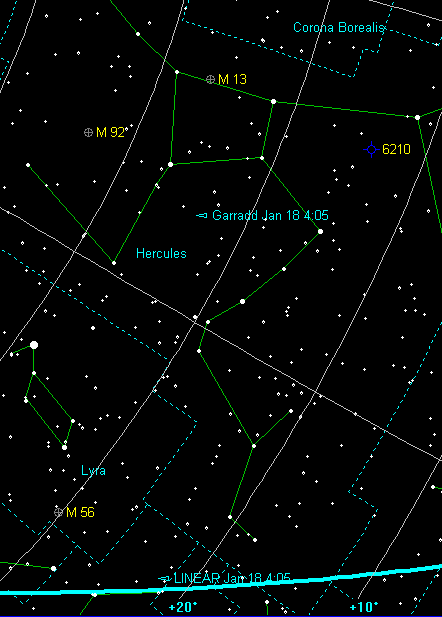
The region I swept. Copied from MegaStar5
Air temperature was
-8 degrees Celsius, the
lowest in this winter. I put a pair of chemical heating pads under the
toes in
my polar boots. But it was not enough to heat my feet and I added
another pair
of the pads under my heels.
I believe the comet looked wonderful because of this coldness that
amplified
the transparency of the air. The hard work under the low temperature
was
rewarded.
Monday,
January 9
I have been in Maui, Hawaii, at the end of
last month. This travel was not focus only on the star gazing, but we
visited Mt.
Haleakala (3055 m) 4 times during our stay.
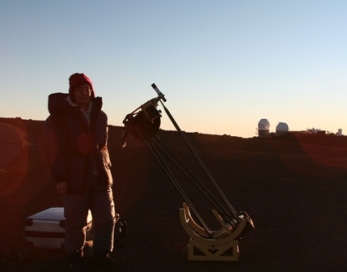
The top of Haleakala. The taller dome is Pan-STARRS telescope.
At the first trip to the Haleakala trip the sky was clear. We enjoyed
taking
photos and the sunset at the top (the parking at an altitude of 3049
m). There
are some telescope domes at the top. The taller dome on the photo is
the Pan-STARRS
telescope with 1.8 m primary mirror, one of the robotic surveys. We
comet
hunters compete with this telescope.
http://pan-starrs.ifa.hawaii.edu/public/home.html
I tried to comet hunt with Pan-STRRAS there, but at the top the wind
was too
strong to observe. Then, we moved down to the second parking (2990 m).
Even at
the second parking gust attacked the telescope many times and we
started heading
for our hotel in a couple of hours.
The second trip was heavy storm. It was expected that the sky might be
clear at
the top but it was not. This was just a round–trip to the top.

The third parking. Lower left is light pollution in Kahului city.
At the third trip the wind was strong again and I set up my 30 cm
telescope at
the third parking (2845 m). I took some photos using a small tripod,
and after an
hour I noticed a part of the sky got darker. It was fractus and at the
next
moment it began to rain. I took down my telescope as soon as possible.
The
intensity of rain got stronger with time, and changed to the storm.
At the parking I met Mr. Jun Lee, Kaze Enterprises.Llc with many
Japanese
tourists. He is a cheerful tour guide of Haleakala sunset or sunrise
tour. They
were lucky as it started raining just after they left the parking for
their
hotels.
At the fourth trip the wind was extremely strong. I parked at the third
parking
and met Mr. Lee with his guests again. He said they went down to the
lower site
since the wind was too strong to observe. I followed their vehicle and
set up
my telescope at an altitude of 1770 m with them. When I ate supper in
my car
the sudden gust hit my telescope and it fell down flat. Luckily, the
damage was
not very serious. The finder adaptor made from wood plate was destroyed
but the
finder itself was safe.
Mr. Lee told me December and January are the worst season. The weather
is
unstable and the wind is generally strong. But this December is
abnormal, he
added. In fact the wind had been strong even in the city and a strong
wind advisory
was released all over the Hawaii Islands. I noticed that the seeing was
as deteriorate
as that in Japanese winter.
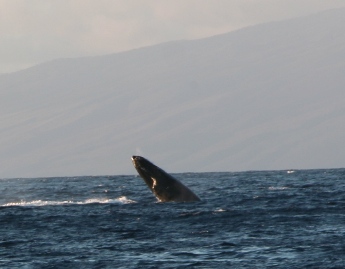
I took a snap shot of the whale jump. This whale was estimated to be
45-50 m in
length.
Stargazing was not successful but we enjoyed whale watching and other
activities in Hawaii.
Top of this page







